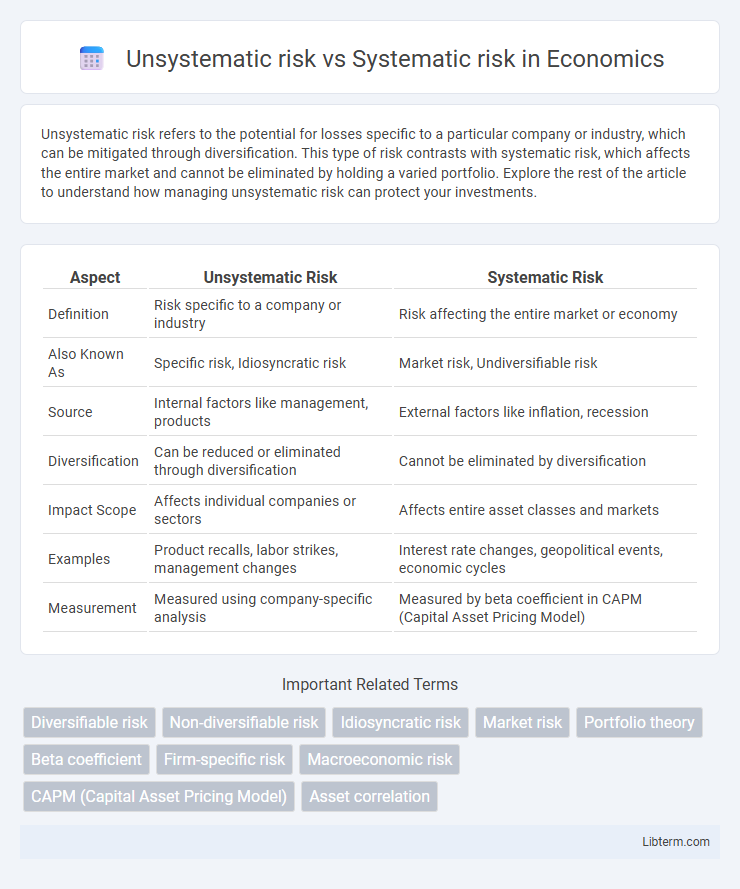Unsystematic risk refers to the potential for losses specific to a particular company or industry, which can be mitigated through diversification. This type of risk contrasts with systematic risk, which affects the entire market and cannot be eliminated by holding a varied portfolio. Explore the rest of the article to understand how managing unsystematic risk can protect your investments.
Table of Comparison
| Aspect | Unsystematic Risk | Systematic Risk |
|---|---|---|
| Definition | Risk specific to a company or industry | Risk affecting the entire market or economy |
| Also Known As | Specific risk, Idiosyncratic risk | Market risk, Undiversifiable risk |
| Source | Internal factors like management, products | External factors like inflation, recession |
| Diversification | Can be reduced or eliminated through diversification | Cannot be eliminated by diversification |
| Impact Scope | Affects individual companies or sectors | Affects entire asset classes and markets |
| Examples | Product recalls, labor strikes, management changes | Interest rate changes, geopolitical events, economic cycles |
| Measurement | Measured using company-specific analysis | Measured by beta coefficient in CAPM (Capital Asset Pricing Model) |
Introduction to Risk in Investments
Unsystematic risk refers to the risk specific to a particular company or industry, such as management changes, product recalls, or labor strikes, which can be reduced through diversification. Systematic risk involves broader market factors like economic downturns, interest rate changes, or geopolitical events that impact the entire market and cannot be eliminated by diversification. Understanding the distinction between these risks is crucial for investors to manage portfolios effectively, balancing both diversifiable and non-diversifiable risks.
Defining Systematic Risk
Systematic risk refers to the inherent risk affecting the entire market or a segment, driven by macroeconomic factors like interest rates, inflation, recessions, and geopolitical events. Unlike unsystematic risk, which is specific to individual companies or industries, systematic risk cannot be eliminated through diversification. Investors must consider systematic risk when assessing portfolio volatility and expected returns, as it represents the market-wide exposure that influences asset prices.
Defining Unsystematic Risk
Unsystematic risk refers to the risk inherent to a specific company or industry, resulting from factors such as management decisions, product recalls, or labor strikes. This type of risk can be mitigated through diversification across different assets or sectors. In contrast, systematic risk affects the entire market or economy, driven by macroeconomic forces like inflation, interest rates, or geopolitical events.
Key Differences Between Systematic and Unsystematic Risk
Systematic risk, also known as market risk, affects the entire market or asset class and cannot be diversified away, encompassing factors such as interest rate changes, inflation, and geopolitical events. Unsystematic risk, or specific risk, is unique to a particular company or industry and can be mitigated through diversification by investing in a varied portfolio. The key difference lies in systematic risk's inherent market-wide impact versus unsystematic risk's company-specific nature, influencing investment strategies and risk management approaches.
Examples of Systematic Risk in Financial Markets
Systematic risk in financial markets includes factors such as interest rate fluctuations, inflation rates, recessions, geopolitical events, and changes in government policies, all of which impact the entire market or large segments. Unlike unsystematic risk, which is specific to a company or industry, systematic risk affects broad market indices and cannot be eliminated through diversification. Examples include sudden shifts in monetary policy by central banks and global economic downturns that lead to widespread asset price volatility.
Sources of Unsystematic Risk
Unsystematic risk arises from factors specific to a single company or industry, such as management decisions, product recalls, or regulatory changes affecting a particular sector. This type of risk can be mitigated through diversification, as it does not impact the entire market. Sources of unsystematic risk include operational inefficiencies, labor strikes, and competitive pressures unique to a firm.
Impact of Risk Types on Portfolio Performance
Unsystematic risk, also known as idiosyncratic risk, affects individual assets or small groups and can be minimized through diversification, thereby reducing its impact on overall portfolio performance. Systematic risk, arising from macroeconomic factors like interest rates or geopolitical events, influences the entire market and cannot be eliminated through diversification, making it a key determinant of portfolio volatility. Effective portfolio management requires balancing these risk types to optimize returns while maintaining acceptable risk levels.
Strategies to Manage and Mitigate Systematic Risk
Systematic risk, influenced by macroeconomic factors such as inflation, interest rates, and geopolitical events, requires strategies like asset diversification across uncorrelated markets and sectors, hedging using derivatives, and investing in inflation-protected securities to manage its impact. Employing tactical asset allocation that adapts to economic cycles and utilizing low-beta stocks can further mitigate systematic risk exposure. Consistent monitoring of economic indicators and adjusting portfolio strategies accordingly enhances resilience against market-wide fluctuations.
Diversification as a Tool Against Unsystematic Risk
Unsystematic risk, also known as specific or idiosyncratic risk, affects individual stocks or sectors and can be significantly reduced through diversification by spreading investments across various assets. Systematic risk, which impacts the entire market or economy, such as interest rate changes or recessions, cannot be mitigated by diversification alone. Effective portfolio management leverages diversification primarily to minimize unsystematic risk, enhancing risk-adjusted returns.
Conclusion: Choosing the Right Risk Management Approach
Effective risk management requires distinguishing between unsystematic risk, which can be mitigated through diversification, and systematic risk, which affects the entire market and necessitates strategic hedging or asset allocation. Investors should prioritize reducing unsystematic risk within their portfolios while employing broader market strategies to manage systematic risk exposure. Tailoring the risk management approach to these distinct risk types enhances portfolio resilience and aligns with long-term financial goals.
Unsystematic risk Infographic

 libterm.com
libterm.com